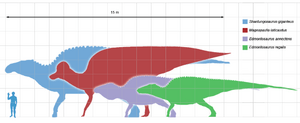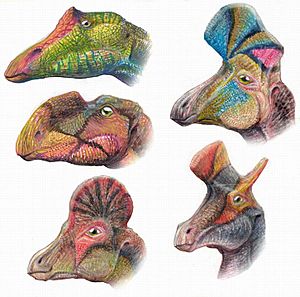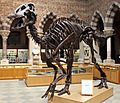Ornithopod facts for kids
Quick facts for kids OrnithopodaTemporal range: Lower Jurassic – Upper Cretaceous
|
|
|---|---|
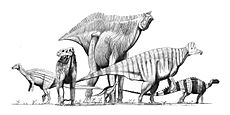 |
|
| Ornithopod dinosaurs. Far left: Camptosaurus left: Iguanodon, centre: Shantungosaurus centre foreground: Dryosaurus, right: Corythosaurus, far right: Tenontosaurus. |
|
| Scientific classification | |
| Kingdom: | |
| Phylum: | |
| Class: | |
| Superorder: | |
| Order: | |
| Suborder: | |
| Infraorder: |
Ornithopoda
Marsh, 1881
|
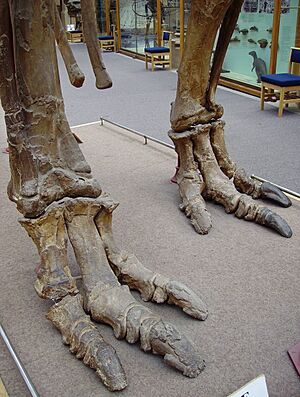
Ornithopods were a group of plant-eating dinosaurs. They are known as "bird-hipped" dinosaurs because of the shape of their hips. These dinosaurs started small and walked on two legs. Over time, they grew much larger and became one of the most successful groups of plant-eaters during the Cretaceous period.
A big reason for their success was how well they could chew their food. They had special beaks, many rows of teeth, and even cheek pouches. This allowed them to chew their food very well. Chewing food into smaller pieces helps dinosaurs digest it faster.
The most advanced ornithopods were the "duck-billed" dinosaurs, also called hadrosaurs. All non-bird dinosaurs, including the ornithopods, died out during the Cretaceous–Tertiary extinction event. We have found ornithopod fossils on all seven continents. However, they are less common in the Southern Hemisphere.
Ornithopods are closely related to horned dinosaurs (Ceratopsia) and hard-headed dinosaurs (Pachycephalosauria).
Contents
Discovering Ornithopods: What Their Name Means
The name Ornithopoda means "bird feet" in Greek. This name comes from their feet, which usually had three toes. Some of the earliest ornithopods, however, had four toes. Unlike some other dinosaurs, ornithopods did not have armor on their bodies. They had a hard, horny beak for eating plants. Some ornithopods also had thin, cartilaginous plates along their ribs. Sometimes these plates turned into rock and became fossils. We don't know exactly what these plates were for.
How Ornithopods Lived and Adapted
Ornithopods became a very successful group of plant-eating dinosaurs. They were everywhere during the Cretaceous period. They started as small, fast dinosaurs that walked on two legs and ate plants. As they grew bigger, they could walk on all four legs. But they could still stand up on their hind legs to reach food or to run away from danger. Hypsilophodon, found on the Isle of Wight in England, is a good example of an early ornithopod.
It might seem strange that these dinosaurs were so successful, as they didn't have obvious ways to defend themselves against meat-eating theropods. They could run fast, and like many plant-eaters, they probably lived in herds for safety. They had tough beaks and some had those rib plates. However, some larger ornithopods, like Iguanodon, had a special defense. They were very strong and had a sharp, dagger-like spike on their thumb!
Early ornithopods were only about 1 meter (3 feet) long. They were likely very quick runners. They had a stiff tail, like theropods, which helped them balance when running on two legs. Later ornithopods became better at eating plants while on all fours. Their spines curved, becoming more like the spines of modern animals that graze on the ground, such as bison. As they spent more time eating while bent over, they became semi-quadrupedal. This means they mostly walked or grazed on all fours. But they could still run on two legs and reach up into trees for food.
Later ornithopods grew much larger. However, they never reached the giant sizes of the long-necked sauropods, which they largely replaced. The biggest ornithopods, like Shantungosaurus, were as heavy as medium-sized sauropods. But they usually didn't grow much taller than 15 meters (50 feet).
Types of Ornithopods
Here are some of the main groups of ornithopods:
- Family Camptosauridae
- Family Dryosauridae
- Family Hypsilophodontidae
- Family Iguanodontidae
- Family Rhabdodontidae
- Family Hadrosauridae
Images for kids
-
An artist's interpretation of Gideonmantellia, sometimes considered one of the most primitive ornithopods
-
Restoration of Muttaburrasaurus, an early iguanodont
-
Skeleton of Dysalotosaurus, a dryosaurid ornithopod from the Jurassic
-
Life restoration of Iguanacolossus, an early styracosternan
-
Reconstruction of Mantellisaurus, a primitive member of the Hadrosauriformes
-
Mounted skeleton of Edmontosaurus, a saurolophine hadrosaur, and one of the last ornithopods
See also
 In Spanish: Ornithopoda para niños
In Spanish: Ornithopoda para niños


